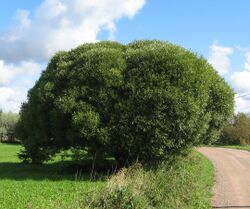Biology:Salix euxina
| Salix euxina | |
|---|---|

| |
| The cultivar 'Bullata' | |
| Scientific classification | |
| Kingdom: | Plantae |
| Clade: | Tracheophytes |
| Clade: | Angiosperms |
| Clade: | Eudicots |
| Clade: | Rosids |
| Order: | Malpighiales |
| Family: | Salicaceae |
| Genus: | Salix |
| Species: | S. euxina
|
| Binomial name | |
| Salix euxina I.V.Belyaeva[1]
| |
| Synonyms[1] | |
| |
Salix euxina, the eastern crack-willow,[2] is a species of flowering plant in the willow family Salicaceae, native from Turkey to the Caucasus.[1] It was first described by I. V. Belyaeva in 2009.[3] It is one of the parents of the common crack-willow, Salix × fragilis.[2]
Description
Salix euxina is a tree that can reach 15–20 m high with a trunk diameter of up to 1 m. It has a wide crown, and old trees develop deeply fissured bark on their trunks. The olive green branchlets are hairless (glabrous) and very brittle at the base, so that branches easily break off. These are able to root and propagate the species. The leaves are pale green and glabrous. They have stomata only on the undersurface. The catkins are relatively thick with somewhat densely clustered flowers.[4]
Salix × fragilis, the hybrid between Salix euxina and Salix alba, has hairs on its branches and branchlets, stomata on both surfaces of its leaves, and slender, more loosely flowered catkins.[4]
Taxonomy
In 1753, Carl Linnaeus described the species Salix fragilis. From at least the 1920s, botanists applied Linnaeus's name "Salix fragilis" both to a pure species and to its hybrid with Salix alba.[4] In 2009, the Nomenclature Committee for Vascular Plants decided to conserve the name "Salix fragilis" for the hybrid,[5] and Irina V. Belyaeva then described the previously unnamed parent species as Salix euxina.[3][4] The epithet euxina refers to the distribution of the species around the Black Sea, known as Πόντος Εὔξεινος (Pontos Euxeinos) in Ancient Greek.[4]
Distribution and habitat
Salix euxina is native to a narrow region around the east of the Black Sea, including northern Turkey, the North Caucasus and the Transcaucasus, where it is found beside mountain streams.[1][4] It has been introduced into parts of Europe (Belgium, European Russia, Great Britain and the Netherlands) and Canada (Ontario and Quebec).[1] In Europe, it is much less common than the hybrid S. fragilis, making up only around 10% of all specimens.[4]
Cultivation
The name "Salix fragilis" was applied in cultivation to plants now recognized as either S. × fragilis, S. alba or S. euxina. One cultivar identified as S. euxina is 'Bullata', popular as an ornamental tree in Europe. It has a short trunk and a very dense globe-shaped crown.[4]
References
- ↑ 1.0 1.1 1.2 1.3 1.4 "Salix euxina I.V.Belyaeva", Plants of the World Online (Royal Botanic Gardens, Kew), https://powo.science.kew.org/taxon/urn:lsid:ipni.org:names:77102927-1, retrieved 2021-08-07
- ↑ 2.0 2.1 Stace, Clive A. (2019), New Flora of the British Isles (4th ed.), Middlewood Green, Suffolk: C & M Floristics, ISBN 978-1-5272-2630-2
- ↑ 3.0 3.1 "Salix euxina I.V.Belyaeva", The International Plant Names Index, http://www.ipni.org/ipni/idPlantNameSearch.do?id=77102927-1, retrieved 2021-08-07
- ↑ 4.0 4.1 4.2 4.3 4.4 4.5 4.6 4.7 Kuzovkina, Yulia A.; Belyaeva, Irina V. (July 2018), Name change alert: Salix × fragilis L., Fact Sheet No 2, University of Connecticut, http://salix.uconn.edu/NameChanges_16_1000370979.pdf, retrieved 2021-08-07
- ↑ Brummitt, R.K. (2009), "Report of the Nomenclature Committee for Vascular Plants: 60", Taxon 58 (1): 280–292
Wikidata ☰ {{{from}}} entry
 |

